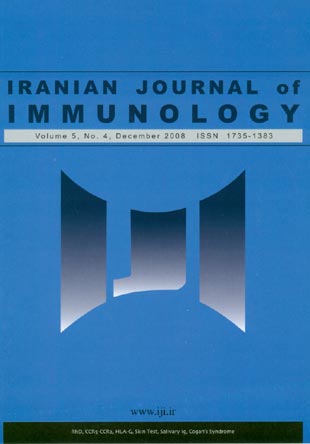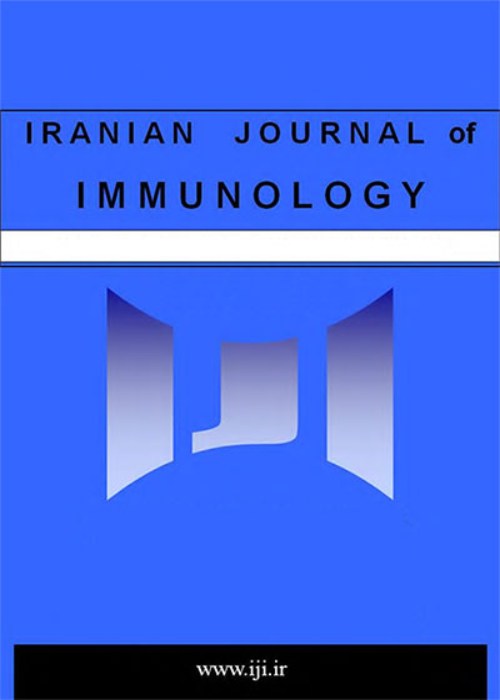فهرست مطالب

Iranian journal of immunology
Volume:5 Issue: 4, Autumn 2008
- تاریخ انتشار: 1387/09/11
- تعداد عناوین: 7
-
-
Page 188RhD antigen is the most immunogenic and clinically significant antigen of red blood cells after ABO system. It has historically been associated with hemolytic disease of the newborn (HDN) which is now routinely prevented by the administration of polyclonal anti-D immunoglobulin. This management of HDN has proven to be one of the most successful cases of prophylactic treatment based on antibody mediated immune suppression (AMIS). Despite the increasing efficiency of treatment, the mechanism of action of anti-D is not completely defined. There is a widespread interest in obtaining a reliable therapeutic monoclonal anti-D, due to difficulty of maintaining a pool of high titer volunteer donors for plasma collection and also increasing demand for antenatal prophylaxis and safety issues with plasma derived products. Candidate monoclonal anti-D preparations should demonstrate appropriate functionality in both in vitro and in vivo assays comparable to polyclonal anti-D immunoglobulin. These criteria are reviewed in addition to the factors regulating development of D specific immune response in D negative individuals and its suppression in HDN prophylaxis.
-
Page 201BackgroundDespite advances in the medical care of renal transplant recipients which have led to an improvement in allograft survival, renal allograft rejection is still a major obstacle to successful organ transplantation. Understanding the mechanisms contributing to allograft rejection will be of great importance for the development of efficient antirejection strategies.ObjectiveThe aim of current investigation was to study the impact of polymorphisms of CCR5Δ32, CCR5- 59029 A/G and CCR2-V64I on renal allograft survival.MethodsUsing PCR and PCR-RFLP methods in 84 renal transplant recipients, the influence of CCR5Δ32, CCR5- 59029 A/G and CCR2-V64I polymorphisms on renal allograft survival in two rejector and non-rejector groups were examined. Rejector group was defined as having rejection before 1 year and non-rejector group had stable graft function at least for 5 years.ResultsSignificant reductions were found in the risk of renal transplant rejection in recipients possessing the CCR2-64I (A) allele (p=0.03) or 59029-A allele (p=0.03) compared to non-rejector group. There were no significant differences in the frequency of CCR5Δ32 polymorphism in rejector group compared to non-rejector group (p>0.05).ConclusionIt was possible to conclude that the chemokine receptors CCR2-V64I (A) and CCR5- 59029 A alleles may influence renal allograft survival.
-
Page 207BackgroundHLA-G gene contains 15 alleles including a null allele, HLA-G*0105N. Previous studies have shown that HLA-G*0105N does not encode the complete HLA-G1 or HLA-G5 isoforms but encodes a functional HLA-G protein with the ability to inhibit NK cell cytolysis. Thus, although the biological functions of HLA-G1 and HLA-G5 proteins are abrogated, other isoforms such as HLA-G2 can replace their roles. Studies on the null allele of HLA-G gene could be useful in understanding the genetic variants of HLA-G alleles in ethnic groups.ObjectiveThe goal of this research was to determine the frequency of HLA-G*0105N null allele in Iranian healthy subjects.MethodsThe frequency of HLA-G*0105N null allele was evaluated in Iranian healthy subjects by PCR-RFLP method. Genomic DNA was isolated from the whole blood of 100 randomly selected, healthy, unrelated Iranian individuals using salting-out technique followed by PCR amplification of the exon 3 of HLA-G gene. PCR products were digested with PpUM-1 and the resulted fragments were analyzed using gel electrophoresis.ResultsIn this study the restriction enzyme digestion confirmed homozygous HLA-G*0105N null allele for 9 % of the population. Furthermore obtained results indicated that the total frequency of HLA-G*0105N null allele was 20 % in the studied population of Iran.ConclusionThe final data analysis showed that the total frequency of this allele in Iranian people was higher than other ethnic groups that have been studied so far.
-
Page 212BackgroundThe risk of developing tuberculosis is high among chronic hemodialysis patients. The tuberculin skin test (TST) has been in use for diagnosing latent TB, but few data are available on TST in hemodialysis patients.ObjectiveThis study was done to identify the TST reactivity and frequency of booster effect in serial TST among hemodialysis patients.MethodsA total of 100 patients in three hemodialysis centers were prospectively tested. Patients with less than 10mm indurations were given additional TST one and four weeks later to determine the frequency of booster effect.ResultsThe cumulative prevalence of a positive TST was 7 % for the first test and 16 % for the third test. There was a weak, but significant correlation between TST positivity, serum albumin level, urea reduction ratio and KT/V (p<0.05). There was no influence of age, gender, hemodialysis duration and primary renal disease.ConclusionThis study showed that the TST reactivity and booster effect among our hemodialysis patients in Iran are lower than in other societies. Inadequate hemodialysis and poor nutrition may contribute to the lower tuberculin skin test reactivity in our hemodialysis patients.
-
Page 217BackgroundEarly Childhood Caries (ECC) is one of the most common chronic childhood diseases. In spite of the global decrease in dental caries in the past decades, ECC has become a significant problem in many developing countries and also in a few industrialized nations. Saliva as a host factor can play an important role in the process of dental caries.ObjectiveThe aim of this study was to compare sIgA and IgG as saliva components between ECC and caries-free groups.MethodsIn this cross-sectional study, samples of unstimulated saliva of 90 children (45 in ECC group & 45 in caries-free group) were taken with Scully method. Then the concentration levels of sIgA and IgG were measured with Enzyme Linked Immunosorbent Assay and Single Radial Immunodiffusion methods.ResultsMean concentration levels of salivary sIgA and IgG were significantly higher among children with ECC (p<0.05). There was also a weak inverse correlation between sIgA level and DMFT index in ECC group but it was not statistically significant (p=0.056).ConclusionThe high concentration of salivary immunoglobulin in children with ECC may be associated with an increased antigenic load, leading to high production of antibodies.
-
Page 222


